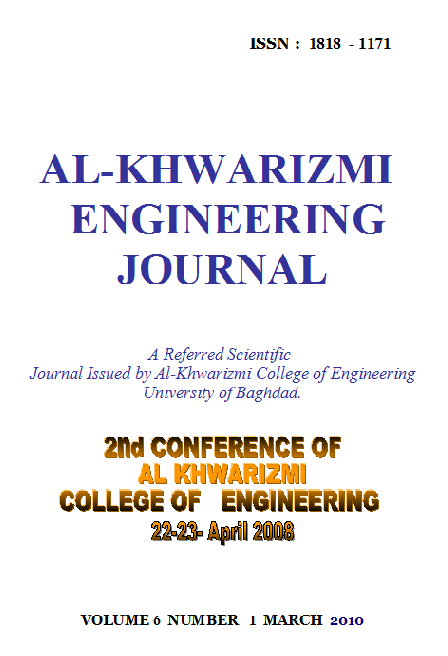Heat Transfer of Single and Binary Systems in Pool Boiling
Abstract
The present research focuses on the study of the effect of mass transfer resistance on the rate of heat transfer in pool boiling. The nucleate pool boiling heat transfer coefficients for binary mixtures (ethanol-n-butanol, acetone-n-butanol, acetone-ethanol, hexane-benzene, hexane-heptane, and methanol-water) were measured at different concentrations of the more volatile components. The systems chosen covered a wide range of mixture behaviors.
The experimental set up for the present investigation includes electric heating element submerged in the test liquid mounted vertically. Thermocouple and a digital indictor measured the temperature of the heater surface. The actual heat transfer rate being obtained by multiplying the voltmeter and ammeter readings. A water cooled coil condenses the vapor produced by the heat input and the liquid formed returns to the cylinder for re-evaporation.
The boiling results show that the nucleate pool boiling heat transfer coefficients of binary mixtures were always lower than the pure components nucleate pool boiling heat transfer coefficients. This confirmed that the mass transfer resistance to the movement of the more volatile component was responsible for decrease in heat transfer and that the maximum deterioration that was observed at a point was the absolute concentration differences between vapor and liquid phases at their maximum. All the data points were tested with the most widely known correlations namely those of Calus-Leonidopoulos, Fujita and Thome. It was found that Thome's correlation is the more representative form, for it gave the least mean and standard deviations.
Downloads
References
[2] Van Wijk, W.R, Vos, A.S., and Van Stralen, S.J.D: Heat Transfer to Boiling Binary Liquid Mixtures, Chem.Eng.Sci, Vol.5, PP.65-80 (1956).
[3] Grigorev, L.N.: Studies of Heat Transfer of Two Component Mixtures, Teplo I Masso Perenos, No.2, PP.120-127 (1962).
[4] Stephan, K., Korner, M.: Heat Transfer in boiling Mixtures, Proceedings of the 7th, Heat TransferConf., Paper RK14, PP.59-81(1982).
[5] Calus, W.F., and Leonidopoulos: Pool Boiling of Binary Liquid Mixtures, Int.J.Heat Mass Transfer, Vol.17, PP.249-246 (1974).
[6] Thome, J.R.: Latent and Sensible Heat Transfer Rates in the Boiling of Binary Mixtures, 20th edition. Joint ASME/AICHE National Heat Transfer Conference, Milwaukee, Wisconsin, also ASME, PP.81-HT-28 (1981).
[7] Stephan, K., and Korner, M.: Calculation of Heat Transfer in Evaporating Binary Liquid Mixtures, Chem.Ing.Tech.Vol.41, PP.409-417 (1969).
[8] Korner, M.: Beitrag Zum Warmeubergang Beider Blasenverdampfung Binarer Gemishe, Ph.D.Thesis, Technical university of Aachen (1967).
[9] Thome, J.R.: Prediction of Binary Mixture Boiling Heat Transfer Coefficients Using Only Phase Equilibrium Data, Int.J.Heat Mass Transfer, Vol.26, PP.965-974 (1983).
[10] Stephen, K., and Preusser, P.: Heat Transfer and Critical heat Flux in Pool Boiling of Binary and Ternary Mixture, Ger.Chem.Eng.Vol.2, PP. 161 – 169 (1979).
[11] Calus, W.F., and Rice, P.: Pool Boiling Binary Liquid Mixtures, Chem.Eng.Sci.Vol.27, PP. 1687 – 1697 (1972).
[12] Scriven, L.E.: On the Dynamics of Phase Growth, Chem.Eng.Sci.Vol.10, PP.1-13 (1959).
[13] Van Stralen, S.: The Mechanism of Nucleate Boiling in Pure Liquids and Binary Mixtures, Int.J.heat Mass Transfer, PP.990 – 1046, 1469 – 1498(1967).
[14] Schlunder, E.U.: Heat Transfer in Nucleate pool boiling of Mixtures, Proc.7th edition, Int.Heat Transfer Conf., Vol.4, PP.2073-2079 (1982).
[15] Thome, J.R.: Prediction of Binary Mixture Boiling Heat Transfer Coefficient Using Only Phase Equilibrium Data, Int.J. Heat Mass Transfer, Vol.26, PP. 965-974(1983).
[16] Wenzel, U., Balzer, F., Jamialahmadi, M., and Muller- Steinhagen, H.: Pool Boiling Heat Transfer Coefficients for Binary Mixture of Acetone, Isopropanol, and water, Heat Tran.Eng. Vol.16, PP. 36 – 43 (1995).
[17] Fujita, Y., Bai, Q., and Tsutsui, M.: Heat Transfer of Binary Mixtures in Nucleate Pool Boiling, 2 nd Eur.Thermi.and 14 thUIT Nat. Heat Trans. (1996), Internet.
[18] Sultan,A.J, Heat Transfer of Single and Binary Systems in Pool Boiling.M.sc Thesis UniversityofTechnology,2006.
Downloads
Published
Issue
Section
License
Copyright: Open Access authors retain the copyrights of their papers, and all open access articles are distributed under the terms of the Creative Commons Attribution License, which permits unrestricted use, distribution, and reproduction in any medium, provided that the original work is properly cited. The use of general descriptive names, trade names, trademarks, and so forth in this publication, even if not specifically identified, does not imply that these names are not protected by the relevant laws and regulations. While the advice and information in this journal are believed to be true and accurate on the date of its going to press, neither the authors, the editors, nor the publisher can accept any legal responsibility for any errors or omissions that may be made. The publisher makes no warranty, express or implied, with respect to the material contained herein.












